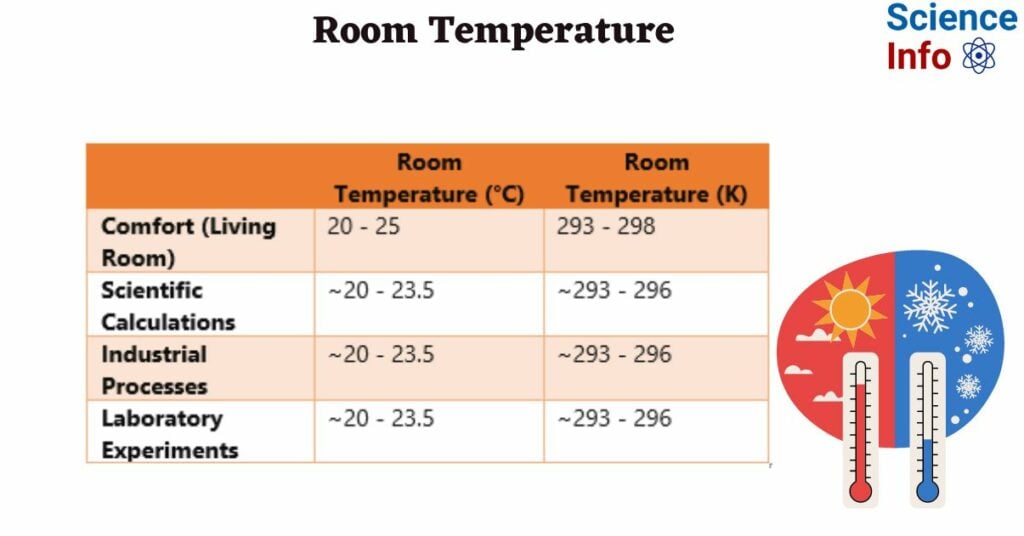The word “room temperature” refers to a temperature range appropriate for human habitation.
A person dressed normally feels neither hot nor cold within this temperature range. To the average individual, room temperature is the reading on the thermometer in the room. The terms “room temperature” and “ambient temperature” are used interchangeably, however, they aren’t referring to the same concept. The ambient temperature is the actual measured temperature of the surroundings. It can sometimes differ from room temperature and may not even be indoor temperature.

Interesting Science Videos
What is Room Temperature?
The temperature of a room is defined as the reading from a thermometer. Room temperature typically refers to the range of temperatures that are comfortable for humans indoors without the need for additional heating or cooling. Most people use either their home’s typical temperature or the temperature they set on the thermostat.
Room temperature is frequently determined by general human comfort, with a common range of 18°C (64°F) to 23°C (73°F), while climate differences may use people to higher or lower temperatures—for example, 78°F may be a common temperature for some people.
Room temperature varies based on the objectives or purposes for which it is being evaluated. Here are some of the considerations:
Room Temperature for Human Comfort and Health
Individual demands, as well as factors such as location and activity, influence human comfort concerning room temperature. The West Midlands Public Health Observatory recommends 21°C (70°F) for living rooms and 18°C (64°F) for bedrooms to encourage comfort and health. Furthermore, research shows that maintaining a maximum temperature of 22.0°C (71.6°F) in interior areas promotes a positive perception of air quality and cooperation.
Room Temperature for Scientific Calculations
Scientific calculations commonly use a room temperature range of 20-23.5 degrees Celsius (68-72.8 degrees Fahrenheit). This range, approximately 293 to 296 kelvins (K) or 528 to 537 degrees Rankine (°R), serves as a standardized foundation for computations and testing. While specific definitions of ambient temperature may differ, they provide a useful reference point for scientific investigation.
Room Temperature for Lab Experiments
Room temperature provides a reliable baseline for scientific and commercial experiments, providing a comfortable working atmosphere and consistent circumstances. Researchers frequently choose to conduct experiments at room temperature unless special temperature control is required for their goals. Using standardized tables and reference materials, researchers can anticipate and account for temperature-dependent events in their studies.
- Since many material properties and physical constants may be accurately determined at 20°C (68°F), it is advantageous for experimenters that room temperature is so close to this temperature. Researchers can more precisely estimate results, including the rate of chemical reactions, for room-temperature studies by using standardized tables.
- It’s usually more convenient to work at ambient temperature unless there’s a specific need for temperature control. Room temperature is sufficient for carrying out experiments well, even in situations when a controlled temperature is beneficial but not necessary.
- Large experimental spaces with insufficient heating and cooling systems, such as warehouses, may find it difficult to keep the temperature at room temperature.
- It is best to record the conducted work at an approximate ambient temperature if the experimental work takes place at a temperature that deviates significantly from the range of 20 to 23.5 °C.
- It is possible to use assumed normal ambient temperatures in general computations. An internal combustion engine’s thermal efficiency, for example, may be stated without mentioning the air temperature, even though efficiency does change with ambient temperature, especially in situations where intense heat affects air density.
Difference Between Ambient Temperature and Room Temperature
| Ambient Temperature | Room Temperature |
| Refers to temperature with less precision compared to “room temperature” | Offers slightly more specificity than “ambient temperature” |
| Often used interchangeably with “room temperature” | Pertains specifically to the temperature within an enclosed space, typically a room |
| Precision may not always be crucial, particularly in laboratory contexts | Used when discussing temperature variations within a room, like localized heating from electronic devices |
| Applicable In fields where slight temperature differences are unimportant, the differentiation may not be relevant | Applicable for the specific conditions for the experiment. |
| Generally denotes the overall temperature of the surrounding environment which is around 68 Fahrenheit or 20 degree celcius. | Often assumed to hover around 20°C (68°F) but subject to variation due to factors such as heating, cooling, and insulation |
References
- https://sciencenotes.org/what-is-room-temperature/
- https://www.newworldencyclopedia.org/entry/Room_temperature
- https://www.greenmatch.co.uk/blog/ideal-room-temperature
- Helmenstine, Anne Marie, Ph.D. “Room Temperature Definition.” ThoughtCo, Aug. 26, 2020, thoughtco.com/definition-of-room-temperature-in-chemistry-605625.
